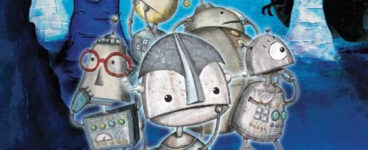David Robinson Reviews
‘The real value of churches, he maintains, is that they hold the past and present, decay and use, in a rare balance, that their buildings have a poetry and spirituality about them that only intensifies as they come under threat.’
David Robinson finds the beauty of church, art, and community in Peter Ross’s latest travelogue, Steeple Chasing.
Steeple Chasing: Around Britain by Church
By Peter Ross
Published by Headline
At the last four funerals I have been to, there hasn’t been a single hymn. I shouldn’t be too surprised: the growing unpopularity of Christian rituals of death is one of the signs of our times. As an example, consider this: direct cremations (no service, no mourners) used to be almost unheard of – even murderers and paupers got some sort of ceremonial send-off into the afterlife. Now they account for one in four of all funerals.
That’s how we are with death these days: increasingly, we’re giving it the cold, secular shoulder. We don’t want religious funerals in churches or chapels (none of my last four were), so the numbers have dropped by 80 per cent in the last decade. Bad news for the clergy and undertakers is good news for supermarkets and off-licences: according to the Co-op – which conducts 100,000 funerals a year – 21 per cent of us feel that the wake is more important than the funeral service.
So where does this leave Britain’s churches, those great traditional portals on the infinite? If we have lost faith in Christianity so much that we don’t even want to use its rites at the one moment when they might offer consolation, what’s the point in keeping churches open in the first place? As congregations dwindle and roof repair bills rise, can they ever be anything more than a costly irrelevance?
Such questions are at the heart of Peter Ross’s Steeple Chasing, an ecclesiastical echo of his graveyard explorations in A Tomb With A View, which went on to win the 2021 Saltire Non-Fiction Book of the Year award. The titular pun indicates that this is to be a journalistic journey: with 16,000 Anglican churches in England alone, anything other than an impressionistic survey of British Christianity’s ebbing sea of faith is impossible. For all that, his book is never less than fascinating, and even though some of its stop-off points are familiar (Lindisfarne, Durham, St Paul’s Cathedral), his chapters on the wooden angels guarding the medieval hammerbeam roofs of so many East Anglian churches, the Great East Window at Gloucester, Stanley Spencer’s painting The Resurrection of the Soldiers at Sandham in Hampshire, and the medieval mural The Ladder of Salvation of the Human Soul at Chaldon in Surrey have inspired me to add them all to my bucket-list.
Ross isn’t a believer himself, but his journalism has always been marked by the kind of deep empathy that makes this irrelevant. More than that, he knows where the core of a good story lies, and has a nose for the telling quote. So at Pluscarden Abbey, a monk tells him ‘I sometimes think it would be nice to have a wife. Or even a pair of socks’ and that matters every bit as much as the details of the monks’ centuries-old rituals. At Southwark, he tells the story of the cathedral cat’s meeting with the late Queen (‘This is Doorkins Magnificat, Ma’am’) so well that I found myself watching the service of thanksgiving for its life. He tracks down effigies so life-like that they could be horror film extras, talks to steeplejacks about working on buildings that sway in the wind, and tells a story about a Norfolk man who stopped satanists using the local village church and then – in a scene that could come straight from JL Carr’s A Month in the Country – uncovers 11th century paintings of angels on its nave walls.
At London’s St Martin-in-the-Fields (‘Refugees Welcome’) he helps serve meals to the homeless and needy in a chapter that goes on to offer one possible defence of keeping churches open in a post-Christian age – that the role they play in mental health counselling, addiction support groups and so on is, according to Treasury figures, worth a cool £55.7 billion. One does, though, suspect that his heart really isn’t in this purely utilitarian argument. The real value of churches, he maintains, is that they hold the past and present, decay and use, in a rare balance, that their buildings have a poetry and spirituality about them that only intensifies as they come under threat. As the head of a charity dedicated to rescuing such buildings points out, ‘These buildings transcend time. They are the spiritual investment and the artistic legacy of generations and a community’s greatest expression of itself over centuries.’ In France, all church buildings older than 1905 can, in theory, claim state aid for repairs. In Britain, where some 2,000 churches have closed over the last ten years, and where the Heritage Lottery Fund no longer has a special section to deal with churches, they are a lot more vulnerable.
Not all are. As Richard Holloway points out, visits to cathedrals are on the rise. That’s understandable: they are, after all, awe-inspiring in scale even now, as well as being vast repositories of our history – the crypt at St Paul’s Cathedral is nothing less, says Ross, than England’s Valhalla. (Did you realise that the cathedral it replaced after the Great Fire of London was once the world’s biggest? Me neither).
In my own experience, the one church where past and present dissolve into each other most completely is Old St Paul’s in Edinburgh, of which Holloway was once rector, about which he wrote so compellingly in his memoir Leaving Alexandria. Ross does it full justice too, helped by excellent interviews with both Alison Watt, whose superlative painting Still hangs above the altar in the church’s Warrior’s Chapel, and Holloway himself. Personally, it’s art, not faith that imbues the place with such a deep sense of spirituality: the depth of Watt’s art and Holloway’s own writing, or the story I’ve heard him tell of his predecessor as rector, a double Military Cross winner in the First World War who was known for his compassion towards the poor and vulnerable.
Buildings like Old St Paul’s seem to stand outside time in a way that would make perfect sense to quite a number of people Ross interviews. At Durham, the aged guide talks about St Cuthbert and the Venerable Bede as though they are both still living; at Lindisfarne, the former curate of the church next to the priory, tells him that as far as she is concerned Saints Aidan and Cuthbert ‘are just as alive as we are, though in a different state’. And although I wouldn’t go quite so far, I do think that knowledge of the past can, by making us aware of the fleetingness of our own lives, can gift us, however briefly, a sense of timelessness. Of all the reasons for taking up the hobby of what John Betjeman called ‘church-crawling’ – which Ross, tongue only slightly in cheek, suggests ought to be as popular as Munro-bagging – this is, I suspect, the one that chimes the loudest with him: that nowhere else do the past and present slip so easily into each other.
Although not quoted in Steeple Chasing, John Betjeman articulated similar thoughts in the poetry he wrote while serving as the press attache to the British High Commissioner in Dublin in 1941-3, especially those poems written while wandering round increasingly dilapidated graveyards in Church of Ireland country parishes. His poem ‘Emily in Ireland’, for example, ends like this:
There in pinnacled protection,
One extinguished family waits
A Church of Ireland resurrection
By the broken, rusty gates.
Sheepswool, straw and droppings cover,
Graves of spinster, rake and lover,
Whose fantastic mausoleum,
Sings its own seablown Te Deum,
In and out the slipping slates.
The slates slip, the family is extinguished, yet the poem is written in the present tense. The faith of the mausoleum’s builders – and, presumably the accompanying church – still sings out. Maybe the sea of faith is these days just a tideless, emptying pool, but as long as those buildings are there to remind us what it was, our horizons widen retrospectively across centuries, and we can imagine what faith must have felt like even if we no longer feel it ourselves. Peter Ross, I am certain, would completely understand.
Steeple Chasing: Around Britain by Church by Peter Ross is published by Headline, priced £22.
ALSO IN THIS ISSUE

 Music in the Dark: A Q & A with Sally Magnusson
Music in the Dark: A Q & A with Sally Magnusson
‘And yes, I wanted Jamesina Ross to be concerned with bearing witness, because that mattered to peop …

 Alan Windram Reads One Button Benny and the Dinosaur Dilemma
Alan Windram Reads One Button Benny and the Dinosaur Dilemma
‘Every Friday all of the robots would gather together for a huge party, with lots of food, lots of m …














